WALT HANSGEN AT VIR
- by Phil Allen, with thanks to Fred Rice
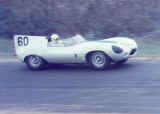 Walt Hansgen did not win
the inaugural race at Virginia International Raceway in August of 1957. He
qualified on the pole but his 3442 cc 250 hp D Jaguar was overpowered by Carroll
Shelby’s 4477 cc 400 hp 450 Maserati. The
margin of victory was only twenty seconds for the 20-lap feature, a tribute to
Alfred Momo’s car preparation and Hansgen’s driving skill considering the
fact that the Jaguar’s top speed was rated at 162 mph and the Maserati’s was
198 mph.
Walt Hansgen did not win
the inaugural race at Virginia International Raceway in August of 1957. He
qualified on the pole but his 3442 cc 250 hp D Jaguar was overpowered by Carroll
Shelby’s 4477 cc 400 hp 450 Maserati. The
margin of victory was only twenty seconds for the 20-lap feature, a tribute to
Alfred Momo’s car preparation and Hansgen’s driving skill considering the
fact that the Jaguar’s top speed was rated at 162 mph and the Maserati’s was
198 mph.
The Briggs Cunningham Jaguars returned to VIR on October 27 of the
inaugural year and this time Hansgen not only won the featured President’s Cup
Race but also the SCCA National Championship points title. The same year he was
named “Best Driver of the
Year” by The New York Times and “U.S. Sports Car Driver of the Year” by
Sports Illustrated.
The 1958 season saw the Cunningham team switch to Lister Jaguars and
Hansgen was once again the winner in the feature at both VIR’s Spring Sprints
and the October run for the President’s Cup. The October race also gave
Hansgen the points for a second National Championship.
May 3 was the only National race recorded at VIR in 1959. The Walt
Hansgen/ Briggs Cunningham combination continued to dominate by winning the
40-lap feature over the Porsche RSK of Don Sesslar.
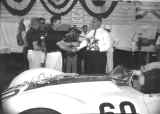
May 1958 |
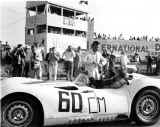
October 1958 |
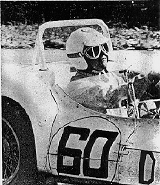
April 1961 |
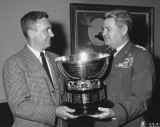
President's Cup awarded
by Gen Curtis LeMay
- 1961 |
The President’s Cup returned to VIR in April of 1961 with a three-hour
endurance race that proved to be a showcase for the Type-61 Birdcage Maserati.
Three different teams earned a place on the podium in identical models
of the three liter Maserati. Hansgen won for team-owner Briggs Cunningham while
Roger Penske finished second in a Telar Birdcage. Third place went to Gaston
Andrey driving for Mike Garber. Cunningham also brought a pair of Cooper Formula
Jr.s for himself and Hansgen. Walt did not finish in the open-wheeled Cooper but
entered it at Watkins Glen in the U.S. Grand Prix in October of that year.
Walt Hansgen’s final appearance at VIR in 1962 was also the final
appearance of The President’s Cup. Just as he had done in the inaugural race
in 1957, Hansgen did not win the feature, but he probably drove his best and
most exciting race ever at the Danville track. Due to mechanical problems on the
Cunningham cars driven by Hansgen and Dr. Dick Thompson, the team spent Saturday
in a nearby garage making repairs and missed qualifying. Hansgen had entered the
Formula Jr. race in a Cooper Climax and the President's Cup in a Cooper Maserati.
Peter Revson was on the
pole for the Formula Jr. event in Teddy Mayer’s Cooper next to second fastest
Roger Penske. Hansgen was forced to start at the back after missing the Saturday
session. At the drop of the green he charged through the entire field on the
front straight and was close behind Penske into turn one. He took the lead by
lap three and was never headed.
 The featured President’s Cup event started at 3:30 and was shortened to
two and a half hours because of impending darkness. Penske started on the pole
in his Cooper Monaco and Hansgen was gridded 16th, once again paying
the price for having missed qualifying. Throughout the history of VIR the track
has been known for bad luck with the weather. April 29, 1962 was probably the
worst. When the feature started, 20 cars picked up speed and so did the rain. In
a pelting storm that was so heavy spectators could not even see the track,
Hansgen immediately set out to repeat his spectacular performance from the
Formula Jr. race. Once again he was in second place behind Penske by the first
turn and again he took over the lead by lap three. His Cooper Maserati seemed
destined to run away from the entire field until the driving rain shorted his
plugs at the forty-minute mark. After a six-minute pit stop he rejoined the race
two laps down and in ninth place. Now the real show began. Lapping at a record
setting pace he caught and passed the leaders and quickly moved ahead by over
ten seconds. His charge ended when the checkered flag fell. Had the race not
been shortened by a half hour he was on his way to making up the second lap and
a stunning win.
The featured President’s Cup event started at 3:30 and was shortened to
two and a half hours because of impending darkness. Penske started on the pole
in his Cooper Monaco and Hansgen was gridded 16th, once again paying
the price for having missed qualifying. Throughout the history of VIR the track
has been known for bad luck with the weather. April 29, 1962 was probably the
worst. When the feature started, 20 cars picked up speed and so did the rain. In
a pelting storm that was so heavy spectators could not even see the track,
Hansgen immediately set out to repeat his spectacular performance from the
Formula Jr. race. Once again he was in second place behind Penske by the first
turn and again he took over the lead by lap three. His Cooper Maserati seemed
destined to run away from the entire field until the driving rain shorted his
plugs at the forty-minute mark. After a six-minute pit stop he rejoined the race
two laps down and in ninth place. Now the real show began. Lapping at a record
setting pace he caught and passed the leaders and quickly moved ahead by over
ten seconds. His charge ended when the checkered flag fell. Had the race not
been shortened by a half hour he was on his way to making up the second lap and
a stunning win.
The Cunningham/Hansgen era came to an end for VIR fans in 1962. The
pairing had been a great boost for Walt’s career. In his introduction to motor
sports, he had watched many early races at the old Bridge Speedway near his home
in Westfield N.J. Not satisfied with merely watching, he began practicing on a
homemade dirt track built on the family’s farm in Somerville, N.J. He
purchased his first Jaguar and began racing at Bridgehampton in 1951. He
finished fifth in his first race. Operating a Jaguar dealership with his father,
Walt raced his own D-Type so successfully that he was invited to join the Briggs
Cunningham team. Jaguar’s history web site lists Walt’s XKD chassis number
529 as being undefeated with Hansgen at the wheel and reports that Walter Hill
in Florida now owns the car.
Hansgen continued with Cunningham in 1962 and 1963, driving a Maserati
Tipo 151 at Le Mans with Bruce McLaren in 1962 and a Jaguar XKE at Sebring, Le
Mans and Road America with Augie Pabst in 1963.
The Cunningham team disbanded but VIR fans were able to keep track of
Hansgen in other venues. 1964 saw him finish third in a NASCAR stock car race at
Watkins Glen behind Buck Baker and ahead of LeeRoy Yarbrough.
He also arrived at Indy in 1964, qualifying in the top ten and finishing
thirteenth in the MG-Liquid Suspension Offy. He finished fourteenth in the same
car in 1965 and was scheduled to enter at the Brickyard in 1966.
His second entry into the world of Formula 1 took place in October of
1964 when he was chosen by Colin Chapman to drive the third Lotus team car at
Watkins Glen. His fifth place finish earned him two points toward the World
Championship.
After the Cunningham team ride ended, Hansgen’s next regular drive was
with the Mecom Racing Team. John Mecom Jr. hired Walt as his road racing manager
and he drove a variety of cars including a 275 LM Ferrari and a Lola.
Both on and off the track he developed a relationship as a mentor to a
young driver named Mark Donohue. He encouraged and coached young Donohue while
sharing Mecom Racing Team driving duties with him on several occasions in the
Ferrari and the Lola. In his autobiography The Unfair Advantage, Donohue credits
his biggest break in racing to his friendship with Walt Hansgen. At another
point in the book he describes his “unfair advantage” over other racers as
being this same friendship. The relationship served Donohue well and he went on
to Trans Am and Can Am Championships as well as winning the Indy 500.
At the beginning of the 1966 racing season Hansgen was recruited by
Holman and Moody as a lead driver for their Ford Mark 11 in Ford Motor
Company’s all-out assault on endurance racing in general and in the 24 Hours
of Le Mans in particular. Hansgen insisted on having Donohue as a co-driver. The
duo took the 450 hp, 427 cu.in. monster to a third place finish in the 24 Hours
of Daytona in a photo-op finish that was orchestrated by the Ford executives.
Both drivers knew they could have finished better. At Sebring they finished a
distant second because of brake problems.
After Sebring Hansgen began to concentrate on preparation for two big
events in May and June. His third Indy 500 was coming up on Memorial Day and
before that he traveled to France to fine-tune the Ford for the 24 Hours of Le
Mans. While practicing on a wet track he lost control and drove down an escape
road. He was not aware that a barrier had been placed across the escape lane and
he crashed heavily. He died three days later in a French hospital on April 7,
1966. He was 47.
 Walt Hansgen did not win
the inaugural race at Virginia International Raceway in August of 1957. He
qualified on the pole but his 3442 cc 250 hp D Jaguar was overpowered by Carroll
Shelby’s 4477 cc 400 hp 450 Maserati. The
margin of victory was only twenty seconds for the 20-lap feature, a tribute to
Alfred Momo’s car preparation and Hansgen’s driving skill considering the
fact that the Jaguar’s top speed was rated at 162 mph and the Maserati’s was
198 mph.
Walt Hansgen did not win
the inaugural race at Virginia International Raceway in August of 1957. He
qualified on the pole but his 3442 cc 250 hp D Jaguar was overpowered by Carroll
Shelby’s 4477 cc 400 hp 450 Maserati. The
margin of victory was only twenty seconds for the 20-lap feature, a tribute to
Alfred Momo’s car preparation and Hansgen’s driving skill considering the
fact that the Jaguar’s top speed was rated at 162 mph and the Maserati’s was
198 mph.

